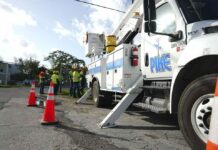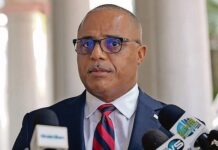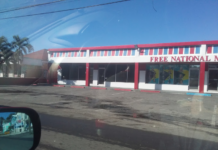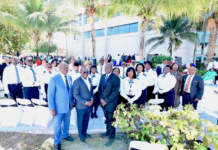2024 Atlantic hurricane season. This season — which commences June 1 and ends November 30
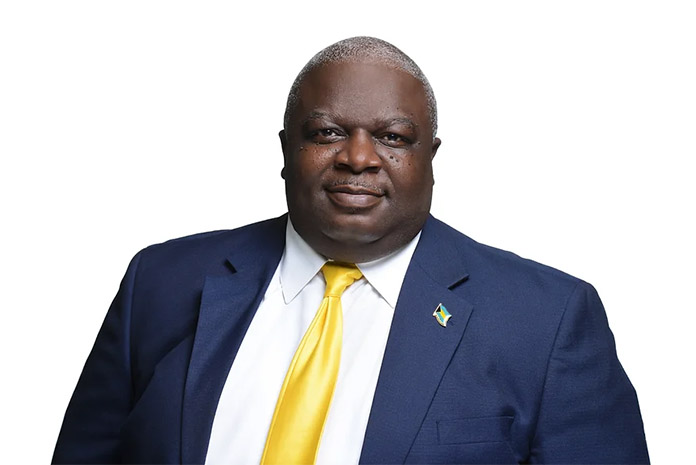
NASSAU, The Bahamas – The newly formed Disaster Risk Management Authority (DRM Authority), held a press conference, June 4, 2024 to mark the official opening of the 2024 Atlantic hurricane season. This season — which commences June 1 and ends November 30 — is anticipated to be the most active one seen in decades. The press conference took place at the Disaster Risk Management Operations Centre, formerly NEMA, on Gladstone Road.
In attendance were: Minister of State in the Office of the Prime with the Responsibility for Disaster Preparedness and Management, the Hon. Leroy Lundy, along with several officials, DRM Authority Managing Director Aarone Sargent; DRM Authority Chairman Alex Storr; Director/former National Emergency Management Agency (NEMA) Captain Stephen Russell; and Permanent Secretary, Marcellus Taylor.
Delivering brief remarks, Minister Lundy assured the public that the government is taking every precaution to ensure the safety and welfare of Bahamians during the season.
“Our vision is clear: to have a country where every citizen and resident feels secure in the face of a storm. The government, along with our dedicated agencies, has been working relentlessly to enhance our disaster preparedness and response capabilities. Central to these efforts is the establishment of the Disaster Risk Management Authority (DRM Authority), a body created to streamline and strengthen our disaster management functions,” said Mr. Lundy.
“The formation of the DRM Authority represents a pivotal change in our approach. By merging NEMA and the [DRM Authority], we have created a unified entity focused on preparing for, mitigating, and responding to disasters with unparalleled precision and efficiency. This consolidation ensures a comprehensive and cohesive framework for disaster risk management, embracing innovation to fortify our resilience.”
The National Oceanic and Atmospheric Administration (NOAA) projects 8 to 13 hurricanes, with 4 to 7 of those being major hurricanes. Mr. Lundy said that this ‘sobering’ forecast requires the highest level of preparedness and vigilance.
As Bahamians, he said, the nation has “faced the wrath of nature time and again” with hurricanes such as Frances, Joaquin, Matthew, and Dorian, which “have tested our resilience and left indelible marks on our history. However, it is from these trials that we draw our strength and resolve. Today, I stand before you with an unwavering determination to outline our vision for a resilient and prepared Bahamaland.”
He explained that the DRM Authority is tasked with developing and implementing the National Disaster Risk Management Plan and the National Disaster Emergency Plan. These strategic blueprints, he said, cover risk assessment, disaster risk mitigation, preparedness measures, financial safeguards, and the strengthening of governance frameworks.
“Our ultimate goal is unequivocal: to enhance the safety and security of our citizens in the face of hurricanes,” he said. “Our nation sits in the heart of Hurricane Alley, and the predictions are daunting. Yet, I have complete faith in the dedication and capability of the agencies represented here today to protect our people and our future. The Royal Bahamas Defence Force, the Royal Bahamas Police Force, the Water and Sewerage Corporation, BPL, BTC, Aliv, The Department of Meteorology, The Department of Family Island Affairs, our Emergency Support Function Groups (ESFs), and the DRM Authority all stand ready to meet the challenge.”
He said that each agency plays a critical role in disaster preparedness and response strategy. He said that the government has been fortifying its ability to meet the requirements to meet its objectives, including upgrading the incident command systems for more effective coordination during disasters and deploying satellite data systems throughout the Family Islands to provide real-time, high-quality insights for decision making. “Additionally, we are partnering with regional allies to incorporate advanced technologies such as Unmanned Aerial Systems for rapid damage assessment and AI-driven early warning systems, thereby enhancing our ability to respond swiftly and effectively,” he said.
Mr. Lundy pointed out, however, that the government needed every Bahamian to take personal responsibility for their own preparedness. “Our message is simple and urgent: Don’t wait! Get storm-ready now! Take the necessary steps to protect your home, your family, and your business. Ensure you have your supplies: stock up on canned goods, shutters or plywood, extra prescriptions, and other essentials. Make a plan and communicate it with your loved ones. Knowing what to do in the event of a hurricane can save lives,” he said. “Let us draw from the hard-earned lessons of past storms. We have harnessed those experiences to strengthen our disaster management approach, and now we must apply that knowledge to prepare for what lies ahead.”
Representatives from a cross-section of agencies also gave preliminary reports on the progress in their respective areas. Those contributors included: Senior Officer, Bahamas Department of Meteorology, Jeffrey Greene; Chief Welfare Officer, Department of Social Services, Andrea Newbold; Officer in Charge of Communication in the Royal Bahamas Police Force, Superintendent Marlon Grant; and Officer for Training, Development and Disaster Management in the Department of Public Works, Bradley King. (BIS Photos/Ulric Woodside)



